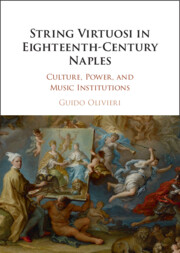Book contents
- String Virtuosi in Eighteenth-Century Naples
- String Virtuosi in Eighteenth-Century Naples
- Copyright page
- Dedication
- Contents
- Figures
- Tables
- Music Examples
- Acknowledgments
- Introduction
- 1 Music Institutions in Naples
- 2 The Formation of the Neapolitan String Virtuosi
- 3 Cello Virtuosi
- 4 Between Naples and Paris
- 5 Neapolitan Virtuosi in the Public Sphere
- 6 Neapolitan Instrumental Music under the Austrian Domination
- 7 Under the Wings of the Imperial Eagle
- Epilogue
- Bibliography
- Index
1 - Music Institutions in Naples
Published online by Cambridge University Press: 13 January 2024
- String Virtuosi in Eighteenth-Century Naples
- String Virtuosi in Eighteenth-Century Naples
- Copyright page
- Dedication
- Contents
- Figures
- Tables
- Music Examples
- Acknowledgments
- Introduction
- 1 Music Institutions in Naples
- 2 The Formation of the Neapolitan String Virtuosi
- 3 Cello Virtuosi
- 4 Between Naples and Paris
- 5 Neapolitan Virtuosi in the Public Sphere
- 6 Neapolitan Instrumental Music under the Austrian Domination
- 7 Under the Wings of the Imperial Eagle
- Epilogue
- Bibliography
- Index
Summary
Through the study of lists of personnel and records of appointments, the chapter looks at Neapolitan music institutions and illustrates in details the central place of the Cappella Reale, the ensemble that participated in all the official ceremonies and represented the sonic embodiment of the Neapolitan royal power. A remarkable example of the court’s representational culture, the Cappella was impacted by the rulers’ shifting political agendas. The chapter traces the evolution of this ensemble, considering in particular the expansion of the string section during the early eighteenth century. The career of violinist Pietro Marchitelli, leader of the ensemble for about thirty years, is emblematic of the opportunities for social mobility available to some string virtuosi. The ascending trajectory of Marchitelli’s professional path – from his birth in a small village in the province of the Neapolitan kingdom, to his training at the Pietà dei Turchini Conservatory, and finally to his appointment in royal ensemble – is retraced through documentary evidence, such as bank accounts and notary contracts, and demonstrates the social status and wealth attained by musicians, with the support of powerful patronage and of cultural and artistic networks.
Keywords
- Type
- Chapter
- Information
- String Virtuosi in Eighteenth-Century NaplesCulture, Power, and Music Institutions, pp. 20 - 51Publisher: Cambridge University PressPrint publication year: 2023

